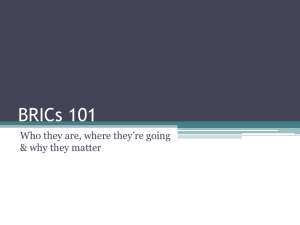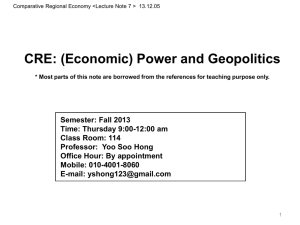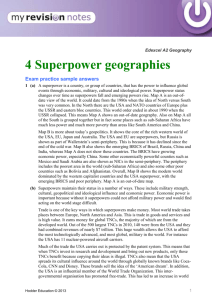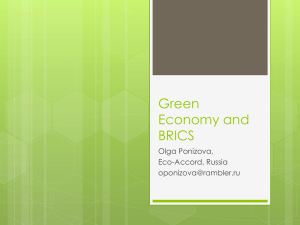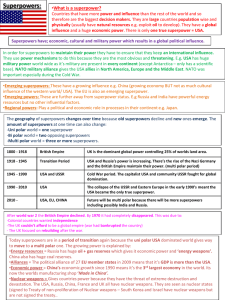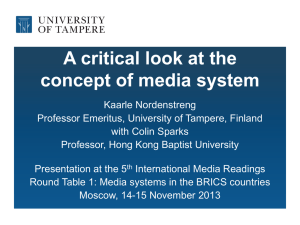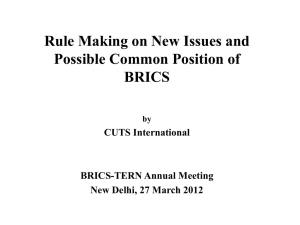lesson 10 shifting powers
advertisement
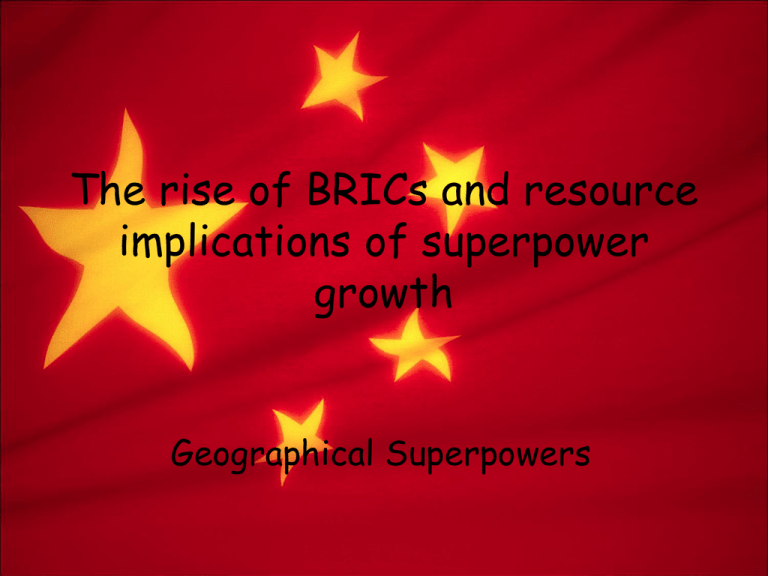
The rise of BRICs and resource implications of superpower growth Geographical Superpowers Superpower Geographies 3. Implications of the continued rise of the superpowers? a) Resource implications of continued growth of superpowers b) Implications of shifting power for older core regions b) rise of emerging powers and the implications for the world c) Tensions between cultures Learning Objectives: •Understand the importance of the rise of BRICs •Understand the implications that growth of superpowers have in terms of energy, water and land •Identify the implications that shifting power has for older core regions Global power shift Atlanticist geography (old) 60% of global GDP but only 18% of the world’s population • Superpower geography does not remain static. • Likely future scenario is that the centre of gravity of global power continues to shift east towards Asia. • The maps illustrate old and new global views of the world: Pacific geography (new) 52% of global GDP but 50% of the world’s population 4.1. 4. Current trends in rising superpowers • • • The BRICs and emerging powers The BRICs (Brazil, Russia, India and China) are the emerging super powers Mexico and the Gulf States could lay claim to be in this group also This group of countries is very different, with perhaps only China capable of challenging the USA in the near future. China Communist one-party state which has become the ‘workshop of the world’; rapid economic growth based on manufacturing and trade; significant military and demographic power Russia Russia is what is left of the USSR; it has a huge nuclear weapons arsenal, and vast oil and gas reserves making it globally important. It has an ageing, unhealthy population and weak economy. India A huge, and very youthful, population give India enormous potential for growth. It has some world class industry such as IT, but very poor infrastructure and 100s millions of very poor people Brazil Increasingly influential in Latin America, with a strong, diversified economy and growing middle class. It tends to punch below its weight internationally. It is sometimes referred to as an ‘agricultural superpower’. Mexico An influential country with strong ties to the USA; Mexico’s economy is often shaky and it has problems with crime and corruption. Gulf States Increasingly important in terms of remaining global oil and gas reserves; has attempted to diversify and become a hub between Europe and Asia, with some success. • The BRICs (Brazil, Russia, China and India) are likely to become more powerful • will not happen overnight • USA (and EU) are not in imminent danger of being relegated to historical geography. Emerging superpowers … • Rise of the BRICS is related to a number of geographic factors … • Size of countries- Russia 1st, China 3rd, Brazil 5th and India 7th • Population – China 1st, India 2nd, Brazil 5th, Russia 8th. • Resources …. See next slide Emerging Superpowers Russia – large quantities of oil and gas India / China Large amounts of coal Brazil – gold, diamonds, iron ore and rainforest But China – doesn’t have vast supply of resources given its population size and area (see Pearson page 97-98 – China and Africa) Emerging powers: who’s who? HDI 0.772 0.817 0.612 0.813 GNI per capita US$ PPP 6710 18 390 3 230 10 260 Broadband internet users (% pop) Unemployment rate (%) 5.0 3.4 0.6 5.2 4.1 9.2 10.7 7.3 GDP from agriculture (%) Population growth rate (%) (2009 data) 10.6 4.7 17.0 6.1 0.7 Russia -0.5 India 1.4 Brazil China 1.2 Copy this map of rising powers and also sketch fig. 4.1 on handout SWOTing the BRICs SWOTing the BRICs SWOTing the BRICs SWOTing the BRICs Very different BRICs BRIC Future based on….. Challenges Brazil Farm exports, hi-tech industry, biofuels Probably has the most potential for ‘smooth’ growth but only recently become politically and economically stable. It may not last. Russia Energy exports Limited manufacturing sector. Political tensions within Russia and at its borders. An ageing, unhealthy population and decaying infrastructure. India Hi-tech industry, outsourcing , manufacturing. Youthful, potentially innovative population. Very poor infrastructure requiring huge investment e.g. roads and energy Huge levels of poverty in rural areas and low levels of education in many areas. Potential water and even food shortages. Manufacturing as the ‘workshop to the world’; own TNCs China Ageing population as a result of the one-child policy. Insatiable demand for resources e.g. oil which may become very costly. Environmental pollution. Internal tensions e.g. demands for democracy. Per capita GDP (PPP), 2009 $10,500 $15,000 $2,900 $6,550 Current trends in rising superpowers MULTI-POLAR future? USA / EU wane, BRIC power grows. • • regional spheres of influence Broad arc stretching from Turkey eastwards to Indo-China: region of: •Unresolved territorial disputes •6 nuclear powers (China, Russia, India, Pakistan, Israel, NATO) •Numerous recent conflicts •Religious conflict •Rogue and troubled states •At least 60% of the world’s remaining oil and gas MULTI-POLAR: the inter-war years Warning from history? • fragmented world • multi-polar world • interwar years in the 1920s and 1930s. What is the current balance between emerging superpowers? Different perceptions: Beijing 2008 and Delhi 2010 Enter the Dragon – China’s global ambitions and significance • China undoubtedly has global ambitions • Since around 2005 it has moved from a focus on its own internal economic growth to a more global strategy: Chinese TNCs • Phenomenal growth. • 40 Chinese TNCs in the Forbes Global 2000 list in 2003, 160+ by 2010 • Most Chinese TNCs are not global ‘brands’ • A few beginning to be known worldwide such as Lenovo (PCs), China Mobile and Air China. • Internal market in China is so huge; Chinese companies do not need to expand abroad, yet. Changing superpowers Shifting patterns of power. Top 10 TNCs by market capitalization (share value) 2000 2010 USA Microsoft USA Exxon Mobil USA General Electric China PetroChina Japan NTT DoCoMo USA Apple Inc. USA Cisco Systems Brazil Petrobras USA Wal-Mart China Industrial & Comm Bank of China USA Intel Corporation USA Microsoft Japan USA Nippon Telegraph & Telephone Exxon Mobil China USA China Mobile Berkshire Hathaway USA Lucent Technologies China China Construction Bank Germany Deutsche Telekom UK/Aust BHP Billiton Cumulative causation / multiplier effect • Useful for explaining growth of China • Free Trade Zones / EPZs attract industry, which subsequently attracts linked industries. 1. How does this work? 2. Does it connect to world systems theory? China spreads its wings • China has increased its foreign aid budget to over $2 billion / yr • China has invested heavily in roads, rail, pipeline and ports in Africa – often via state owned Chinese companies and using Chinese labour. • China has ramped up imports of African oil, minerals and ores – as well as investing in farming and industry in Africa. • Chinese companies have purchased / leased large amounts of land in Africa – even in countries which are considered food insecure. China in Africa • Increased flow of FDI into Africa, • Especially sub-Saharan Africa. • Focussed on oil rich and mineral rich countries • Importing Chinese workers to build key infrastructure such as ports, roads and rail to export raw materials. • Neo-colonialism or desperately needed investment? • China gives increasing amounts of aid to Africa, often targeted at key infrastructure projects. China’s ‘Blue Water’ Navy • Few ‘blue water’ navies capable of deploying worldwide. • China’s navy currently coastal; patrols inshore waters. • Dependence on oil imports - wants to protect shipping routes using own forces • Currently expanding nuclear powered attack submarine fleet and has plans to build aircraft carriers. • Plan to have a navy capable of patrolling out into the Pacific to what it calls the ‘Second Island Chain’. Goodbye G8, hello G20 and G2 • Marginalisation of the old G8 group of OECD countries • Rise of the much broader G20 – which includes China, India and Brazil. • Some commentators have begun to talk of the G2 – the ‘group’ of China and the USA. China’s carbon emissions • China’s carbon dioxide emissions rose by 170% 2000-2010 • 7700 million tonnes by 2009. • Larger than the USA’s 5400 million tonnes. • This means action on climate change, without including China, is increasingly pointless. How has China risen? 1. Read the boxes on p161 Oxford to make a timeline detailing China’s rise (Key moments). 2. Produce a detailed mind map or table as below to show the effects of China’s rise – both positive and negative in terms of social, economic and environmental impacts Positive impact Economic Social Environmental 1. Read Oxford p158-163 Negative impact The Tiger awakes India has a number of assets in favour : • huge population of potential consumers. • youthful population, with no signs of ageing (as in China) • Key hi-tech industries such as IT development and software, space research and nuclear research • educated, English speaking workforce • Innovative global companies such as Tata Motors, Wipro and Infosys The downsides for India are: • Creaking infrastructure which lacks investment; makes transport costly and difficult. • Bureaucracy and red tape - stifles innovation and setting up businesses • Lack on its own resources, especially energy resources • Poverty: 80% of Indian’s live on less than $2 per day – these people are a long way from becoming ‘consumers’ World Bank Ease of doing Business index, 2010 Singapore Hong Kong (China) UK USA Saudi Arabia South Korea Germany Mexico China Brazil India Chad World Rank 1 2 4 5 11 16 22 35 79 127 139 183 Forward together? • China /India bilateral trade has grown from very small beginnings • China wants India’s textiles, iron ore and some other products such as pharmaceuticals. • India needs goods in the form of gadgets, electronics, farm equipment etc from China. • Increasingly technology products made in China were actually designed and software engineered in India (Bangalore), and are serviced and supported in India. • Mutually beneficial trade • Sectors don’t directly compete • Internal market of 2.5 billion people! Problems at home….. • However the future may not be smooth. • Unexpected events happen. • Few people predicted the rapid collapse of the USSR and the end of the Cold War in 1989-1991. • The Asian BRICS all have potentially distracting and destabilising situations on their doorstep: Edging towards a multi-polar world….. • Recent economic and political events have nudged a multi-polar world a little closer: China’s economic expansion The global recession in Africa 2007-2009 •Shows it has ambitions •declining GDP in Europe outside Asia and North America •6-8% growth in China and India China buying American government debt •making the USA reliant on China’s cash pile (a result of its huge trade surplus). China’s global profile •raised by the 2008 Beijing Olympics •the 2010 Shanghai Expo •role in the Copenhagen climate talks. China v India? • • • • • • • • • • Improve Governance Weak institutions and intra-state squabbling contrast with China’s centralised ‘can do’ administration Raise Basic Educational HE tends to be OK, but millions get the most basic, or no, Achievement education; illiteracy is far too high - female literacy is barely 50% Increase Quality and 2.5 million graduates per year, but from just over 300 Quantity of Universities Universities serving a 1 billion + population, which is growing and young. Control Inflation Tends to be variable and frequently spikes at over 8%, which undermines economic growth. Reduce debt India still faces debts of over 70% of GDP which is too high Liberalise Financial Markets India has been much slower than China to open up its markets to global trade, as has a small inefficient financial sector Increase Trade With Trade with the US is about 10% of China’s trade with the US – Neighbours India only accounts for 2% of world trade. Increase Agricultural 60% of employment but only 1% of economic growth; if this Productivity sector does not modernise India faces a future crisis. Improve Infrastructure Major stumbling block to future growth in rapidly urbanising country; road, rail, port, energy and water infrastructure all poor. Improve Environmental Currently not a priority, and public awareness is very low but Quality problems such as sewage and urban air quality are critical. This is information about how India compares to China Write a series of paragraphs explaining which country is more likely to become the next superpower and why. Testing theories on Superpowers Dependency World systems Modernisation How far do real emerging superpowers actually fit into each theory – p 111 handout India China Modernisation Dependency World systems How far do real emerging superpowers actually fit into each theory What is the current balance between emerging superpowers? 1) Outline the key differences between these two rising superpowers 2) How can we apply modernisation theory to them? What stage of Rostow’s model might they be? 3) Do any of the two apply as a ‘peripheral developing country’ according to dependency theory? Explain. 4) Using your knowledge of World Systems Theory, how can the rise of China and India be explained? Homework: To produce a presentation of your ideas about the nature of world super power in 50 years time using your knowledge of superpowers and the theories underpinning them. Key words which must be used: • • • • • • • • • • Dependency theory Wallersteins World systems theory Rostows take off model of economic growth Pacific geography Cumulative causation Kondratiev waves Multi-polar North-south divide BRICs Core and periphery Impacts on resources • • • • Economic development in last 20 years of BRICS newcomers and the expansion of EU to 27 nations, has raised a number of concerns Accelerating rise in demand for energy and other resources Impact on the environment from Global warming to localised river pollution Uneven distribution of the benefits of economic growth, with growing inequality between urban rich and rural poor. Global implications – the environment and resources • • • • • • • • China imports 3% of its coal = 20% of sea-borne world coal trade. China consumes 50% of the world’s cement China uses 30% of steel and 25% aluminum Adds 100GW electricity generating capacity per year Next 30 years, needs to build 1 large nuclear power plant every fortnight to meet demand Greenhouse gas emission increases from China by 2030 will be equal to the increases from the rest of the industrialized world: India’s emissions are likely to rise by 70-80% over the same period. If the Chinese consumed paper at the same per capita rate as the USA, demand would exceed the entire supply of paper today. Nutrition transition and resource demand Impact of resources • • • • Energy Rapid rise in oil prices in 2007 and 2008- outcome of rising demand and stagnating supply Oil may be being pumped out of the ground quicker than new reserves can be found Key concern is the path India and China take as they continue to grow economically and gain powercontinue at same rate as have done since 1990s they will reach GDP levels similar to those of EU and USA Impact of resources Environment • China and India’s ecological footprints may be similar to those of the EU and USA by 2040 = pressure on water, energy and land resources Shifting power and emerging power. • Implications of shifting power for older core regions • In pairs, or threes produce a mind map to identify the issues linked to the rise of the new superpowers and their impacts on the older core regions. Think about – economic, cultural, political issues.
